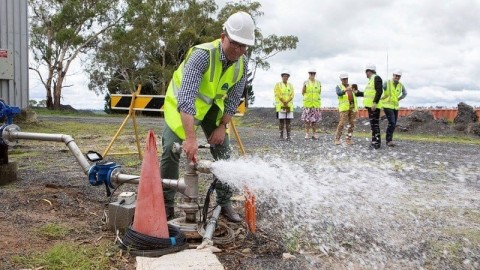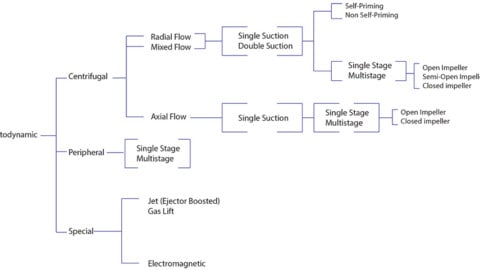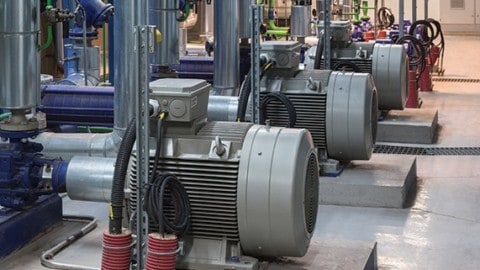by Heinz P. Bloch, PE, Process Machinery Consulting, Robert Bluse, Pump Services Consulting, and James Steiger, HydroAire
In the February 2014 edition of Pump Industry, we published Part 1 of this article looking at the facts and considerations one must take into account when trying to identify a facility for the upgrade of existing pumps. In Part 2, our authors present an actual case study outlining the benefits a competent pump rebuild shop can offer owners of existing pumps.
A recent study on energy efficiency showed that 90 per cent of pumps were not correctly sized. It is well known that many systems are simply sized too large at the project design stage, and incorrectly sized pumps incur higher operating and investment costs. The article reporting on the study stated that energy accounts for fully 94 per cent of the total life cycle cost of pumps (Ref. 1).
This points to the importance of combining maintenance and upgrades when working on pumps. We define maintenance as restoration to the previous condition, whereas upgrading implies optimisation of life cycle costs. Such optimisations are certainly feasible given the status of current pump rebuilding technology and given the ability to take into account changes to a system’s performance which occur over time. In particular, we often find compelling reasons to systematically upgrade the efficiency and potential run length of large (and, sometimes, oversized) centrifugal pumps used in the power generating and Hydrocarbon Processing (HPI) industries.
Of course, this upgrading must be pre-planned so it may be carried out during a maintenance outage. Also, this raises the question of whether an intelligent and well thought-out combination of maintenance and upgrading should be entrusted only to the original equipment manufacturer (OEM), or if qualified non-OEMs should be considered as well.
Dealing with multistage boiler feed pumps
Experience shows that a highly qualified independent rebuild shop with demonstrated capabilities and experienced personnel can offer high-quality upgrades that improve both uptime and efficiency. Such a shop can do so consistently with current pump system performance requirements. With the considerable consolidations in the pump industry, the distinct possibility exists that the OEM may not be able to offer the same engineering competence they previously had and that independent shops should be considered.
Part 1 of this article was published in the February 2014 issue of Pump Industry. This follow-up segment, Part 2, relates an actual case study where a competent pump rebuild shop (CPRS) had been pre-selected just in case a technical issue arose with repairs, a desired schedule had to be met, or upgrading was to be part of an overhaul effort. Pre-qualification emphasises the importance of a CPRS having instant access to hundreds of definitive guidelines on performance-related issues. Permissible clearances between impeller tip and diffuser vanes are among these issues and are best explained by an example. In this instance, it involved a nine-stage boiler feed water pump.
The pump had been previously repaired and was subsequently shipped and reinstalled at the owner’s site. When the field installation crew was ready to hand the pump over to operations, the rotor would not turn and there was zero axial float. The owners lost little time shipping the critically important pump to the pre-qualified CPRS. As soon as the pump reached the CPRS workshop, a work scope was developed on an expedited basis. The CPRS immediately disassembled and inspected the components. To carry out a proper repair, all of the pump’s internal parts had to be accurately measured. Fits and clearances had to be reviewed and recorded in computer-generated sketches (Ref. 2).
Because the CPRS was eminently qualified to perform all-encompassing upgrade work, its personnel analysed, among other tasks, a number of hydraulic issues and did the following:
• Calculated suction specific speed (they were cognisant of the Hydraulic Institute advisory considering as high energy pumps those with specific speed values below 1,300 that generate more than 900 feet of head per stage).
• Calculated suction energy (again, there was an awareness of the differential head value for high energy dropping from 900 feet at a specific speed of 1,300, to only 200 feet at a specific speed of 2,700).
• Calculated NPSH margin.
• Compared susceptibility to internal recirculation-induced damage.
• Verified that radial clearances comply with hydraulic shock avoidance criteria for high (discharge) energy pumps.
Recall (from Part 1) that the CPRS was in possession of comprehensive checklists on pump-internal clearances and upgrade options. Its employees made copious use of these checklists during the incoming inspection and repair scope definition process for this nine-stage pump. Impeller and diffuser gap ‘A’ and ‘B’ modifications were mentioned in the CPRS documentation that had been made available to the user-owner while he made his earlier vendor qualification assessment visits (again see Ref. 2).
CPRS restores recommended radial gap guidelines
It has been observed that not every original equipment manufacturer (OEM) delivers pumps with internal clearances designed and manufactured for optimised hydraulic and mechanical performance. Adhering to the radial gap criteria outlined in Table 1 above is very important. These are based on Dr Elemer Mackay’s widely reported and groundbreaking work with the Electric Power Research Institute
(Refs. 3 and 4).
It should be noted that if the number of impeller vanes and the number of diffuser/volute vanes are both even, the radial gap must be considerably larger (10 per cent minimum).
A repair facility must maximise impeller performance as needed and this CPRS knew what to look for:
1. Bring the impeller middle shroud plate out to the impeller OD to reinforce the impeller structure.
2. Stagger the right and left side of the vane to reduce hydraulic shocks and alter the vane-passing frequency.
3. Avoid even number of impeller vanes for double volute; or, if the diffuser vanes are even numbered, increase the impeller sidewall thickness.
4. Reduce clearances to optimum between shrouds and casing (Gap ‘A’).
5. Impellers manufactured with blunt vane tips can also cause trouble by generating hydraulic hammer even when the impeller OD is the correct distance from the cutwater. The blunt tips cause disturbance in the volute. This effect may be partly or entirely eliminated by tapering the vanes by overfiling or underfiling the trailing edge, as described in many texts, among them Refs. 4 and 5.
Figure 1 shows the deficiency noted during initial dismantling; the diffuser tips are not equidistant from the impeller periphery. The tip clearances had to be brought into compliance with Gap ‘A’ and Gap ‘B’ guidelines by cutting back (Figure 2) and re-contouring the diffuser vane tips. The CPRS quoted a delivery estimate of only two to three days and, upon completion of the project, offered a final report showing documentation in accordance with its quality assurance program.
Shop repair procedures and restoration guidelines
Pump manufacturers usually supply pump maintenance manuals with detailed assembly and disassembly instructions that are either generic, or specific to a particular pump style and model. In essence, a number of important checks should be performed by the CPRS for users whose serious goal is to systematically eradicate failure risk. Both CPRS and user have responsibilities in ascertaining that all quality checks are performed with due diligence.
Experience shows that after years of repairs, many pumps are due for a series of comprehensive dimensional and assembly-related checks. As a minimum, every vital pump deserves much scrutiny. After the well-known dial indicator checks (see Part 1) are complete, the dimensional ‘before vs. after’ findings should be recorded in either the (preferred) electronic, or, as a minimum, paper format. This constitutes part of the documentation, and knowing the before vs. after geometry holds the key to failure analysis and future failure avoidance. A CPRS will take time to record these pump repair data and will be on the road to reach the user’s failure reduction objectives.
Using the CPRS assessment scoring matrix (discussed in Ref. 2), a CPRS will have been pre-selected. Still, when the repair-and-upgrade opportunity presents itself, it is incumbent upon both parties to agree on work scope and critical repair part sourcing decisions. In other words, more definitive repair and restoration guidelines should be consulted in a meeting of user-owner and CPRS representatives at this time. Some of the data provided during the assessment phase of a potential CPRS will have been rolled into an operating mode document that reflects the manner in which the CPRS is conducting business. By that we mean the CPRS will work from written shop procedures, checklists, and upgrading guidelines. Moreover, the CPRS will offer warranties as solid as those of the OEM.
Jointly with the CPRS, the user makes critically important repair part sourcing decisions. The right choice will lower overall maintenance costs by improving equipment mean time between failures. The ultimate effect will be reduced life cycle costs for the pump.
The point is that reliability-focused professionals strongly advocate selecting a CPRS that assists in collecting and examining all the parts of the pump. The CPRS will tutor the client in looking for tell-tale signs of problems on each component. The CPRS will use a thorough checklist and go way beyond the usual repair steps to ascertain that every optimisation opportunity is thoroughly explored and explained. In working with a CPRS, our goal is to purchase knowledge and experience in the process.
The case for a CPRS
Rebuilding a vintage process pump to original OEM specifications makes no sense given current pump rebuilding technology and changes to the system performance that occur over time. However a CPRS, a highly qualified independent rebuild shop with guidelines, checklists, procedures and a willingness to cooperate with the owner-user, can verifiably offer high-quality upgrades that improve both uptime and efficiency consistent with current system performance requirements.
With the considerable consolidations in the pump industry, the distinct possibility exists that the OEM is not able to offer the same engineering competence they previously had. If one simply makes these statements, the issues can be debated for a long time. However, assessing vendor competence and making comparisons using a rigorous and repeatable approach makes the selection process more objective. To the electric power producer, such assessments may, ultimately, be worth a small fortune in maintenance cost avoidance and run length extension.
References
1. Wikstroem, et al; “Supersizing Our Way to Energy Inefficiency”, Supplement to Control Engineering, November 2008.
2. Bloch, Heinz, Robert Bluse and James Steiger; “Combining Pump Maintenance and Systematic Upgrading” ASME POWER2008-60065. Full text also available also from www.hydroinc.com
3. Bloch, H. P. and Budris, A. R., 4th Edition (2013), Pump User’s Handbook: Life Extension, Fairmont Press, Inc. Lilburn, Georgia (ISBN 0-88173-720-8).
4. Bloch, H. P., 1988, Practical Machinery Management for Process Plants Vol.1: Improving Machinery Reliability, Second Edition, Gulf Publishing Company Houston, Texas (ISBN 0-87201-455-X).
5. Bloch, H. P. and Geitner, F. K., 1985, Practical Machinery Management for Process Plants, Volume 4: Major Process Equipment Maintenance and Repair, Gulf Publishing Company, Houston, Texas, (ISBN 0-88415-663-X).


















